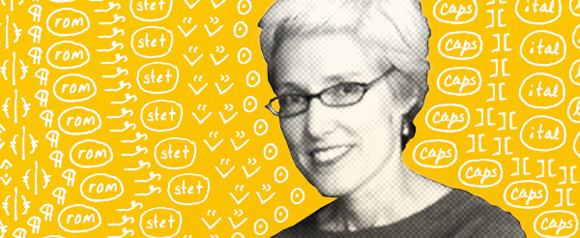| Sun | Mon | Tue | Wed | Thu | Fri | Sat |
|---|---|---|---|---|---|---|
| 1 | 2 | 3 | 4 | 5 | ||
| 6 | 7 | 8 | 9 | 10 | 11 | 12 |
| 13 | 14 | 15 | 16 | 17 | 18 | 19 |
| 20 | 21 | 22 | 23 | 24 | 25 | 26 |
| 27 | 28 | 29 | 30 | 31 |
CATEGORIES
RECENT ENTRIES
BLOG ROLL
In style

“I did my job. It’s his byline, not mine. My colleagues will sympathize when I rail about this. This will make a great dinner-party story. Someday I’ll write a book.”
Channeling the workplace dramas of copy editors everywhere, Carol Fisher Saller wrote that book, titled The Subversive Copy Editor (University of Chicago Press, 2009). Saller, a senior manuscript editor at the press, is the person who (usually) patiently responds to the 3,000 questions submitted each year to the Q&A section of the Chicago Manual of Style’s (CMOS) Web site. The book was "the cumulative effect of reading a lot of anguished questions."
Never read the Q&A? Here’s an example. Note Saller's trademark wit, which, after reading 3,000 of these questions, the average person would be incapable of summoning:
Q: “The menu in our cafeteria shows that enchiladas are available ‘Tues.–Fri.’ However, when I ordered one on a Wednesday, I was informed that enchiladas are available on Tuesday and Friday, not Tuesday through Friday. When I informed the cafeteria manager that this was incorrect, she seemed shocked and refused to change the sign. Please help determine who is correct!”
A: “Although the sign was incorrect, I’m not sure you should annoy the person who provides the enchiladas.”
The Subversive Copy Editor isn’t another style guide; rather, Saller has written a relationship manual for current and aspiring copy editors, offering suggestions for process and organization as well as how to deal successfully with editors and writers while turning out clean, well-styled prose.
I went to the Graham School last week to hear Saller discuss her book and her career. As the Magazine's proofreader for nearly a year-and-a-half, I was hoping to glean a few tips from the grammar guru herself. (You can imagine how daunting it is to be responsible for grammar and style in a magazine published by the same institution that publishes CMOS.) Despite a journalism degree and Catholic-school education filled with diagramming sentences and memorizing lists of prepositions, I’m still learning the trade—and I'm not alone. Around half of the attendees were fellow copy editors looking for wisdom. Several were hoping to one day wield the red pencil and wondered how to stand out during a recession that hasn't been kind to journalism. The master offered three suggestions for success:
- Read—but don’t focus on memorizing—style manuals.
Chicago, MLA, and the Associated Press—which updates its guide annually—are good places to start. Don’t think you have to know all 861 pages of CMOS by heart; no one, not even Saller, does. But if you know the basic rules of grammar and the most common issues of style, and if you have a good feel for the type of information you can find in a style guide, you’ll be in good shape. - Find a mentor to check your work.
There will always be someone who has been editing longer than you have and who knows a few more CMOS rules than you do. She can help. And if you find yourself disagreeing with your editor about whether you need a comma after the word “because,” “fantasizing about your defense is a good learning process.” - Read, read, read.
“The best editors are good readers,” Saller noted, because voracious readers understand what makes good prose. And your reading list needn’t be limited to the style manuals of rule No. 1. Fiction, nonfiction, reference books, cookbooks, blogs, and even comic books count.
Before we headed home to curl up with our own well-worn copies of CMOS, an audience member wanted to know: why subversive?
“People in copyediting already know that you have to break the rules sometimes,” Saller said. “But it’s a dangerous idea to a lot of people.” Spend a few minutes reading the panicked questions submitted to the Q&A, and you’ll agree.
“Plus,” she added, “The Sensible Copy Editor probably wouldn’t sell as well.”
Elizabeth Chan
December 8, 2009
